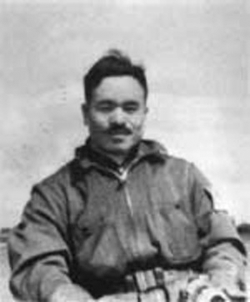Remembering Pearl Harbor: Brad Sekigawa
— Submitted by UH alumnus Brad Sekigawa (UH Mānoa, BBA, 1983)
 This story was related to me by my mother Francine Miura who was 22 years old on December 7, 1941. She lived in Varona Village at Ewa Plantation where my grandfather, Kiyota Miura worked. Their house fronted part of the cane field and just beyond that was Ewa Marine Corps Air Station. In the months prior to the attack, my mom remembers the military conducting exercises on nearly a daily basis as there were rumors of war with Japan brewing for years. Ewa Field was constantly busy with aircraft flying in and out; the heavy loud droning of aircraft made it difficult to hear the radio at times.
This story was related to me by my mother Francine Miura who was 22 years old on December 7, 1941. She lived in Varona Village at Ewa Plantation where my grandfather, Kiyota Miura worked. Their house fronted part of the cane field and just beyond that was Ewa Marine Corps Air Station. In the months prior to the attack, my mom remembers the military conducting exercises on nearly a daily basis as there were rumors of war with Japan brewing for years. Ewa Field was constantly busy with aircraft flying in and out; the heavy loud droning of aircraft made it difficult to hear the radio at times.
On that fateful morning, the whole village was abruptly awakened to the sound of large aircraft formations followed by explosions in the distance from the direction of Pearl Harbor. My mom thought it was unusually early for the military to practice, and on a Sunday.
Just a little after eight she felt something like an earthquake rattling the house. Following that, there was the deafening roar of low flying aircraft and machine gun fire. Curious, she ran outside along with other neighboring kids on street. Out of nowhere came a low flying plane dipping his wing slightly; she could clearly see the pilot in the cockpit waving his hand in a downward motion. She also noticed the red Hinomaru on the side of the airplane indicating it was supposed to be Japanese. She and all the kids thought he was waving “hello” and they all waved back. Coming back a second time, the pilot repeated the gesture, again all the kids waved back at him. On his third pass, my mom saw the pilot slide his canopy back, pull down his scarf revealing a big black moustache, and making a fierce, angry face waved his arm to warn the kids to “get down.” At that moment, that’s when everyone on the street thought that this was real, or something very serious.
Listening to the radio, KGMB broadcast that an attack was taking place at Pearl Harbor, and for all civilians to stay inside their homes, and for all military personnel to report to their duty stations immediately.
In the days following the attack, US Marines from the nearby air station and Army personnel began searching the homes at Varona Village rounding up suspected people of Japanese ancestry. My grandfather served in the Imperial Japanese Army during the Russo-Japanese in 1904-05 having received some medals for basically surviving the war. My grandmother hid medals in the family altar or butsudan which was common in many Japanese homes. My mom remembers these two large men wearing World War I type doughboy helmets; one carrying a rifle, and the other with a pistol.
After searching the house they came to the altar, the soldier started opening the small tiny doors and saying to his buddy, “Hey what do you think is in here?” The one with the rifle said, “I dunno, maybe that’s where they store the ashes of the dead.” Upon hearing that, the soldier slammed the little doors and said, “OK! There’s nothing here! Let’s go!” My grandfather missed being interned at Honouliuli by my grandmother’s quick thinking.
As a postscript I have often wondered who that pilot was. All my mom remembered was the big black moustache, the gray airplane with the large red ball on the side. Having done research for the USS Arizona Memorial for more than thirty years, I have come to the conclusion that the pilot was most likely Lt. Shigeru Itaya, leader of the Zero fighter squadron from the flagship Akagi. Based on surviving group photos of the Japanese fighter pilots and the units known to have attacked Ewa Field that day, he is the most likely person my mom saw that day.
*Submission has been slightly edited for clarity purposes.
